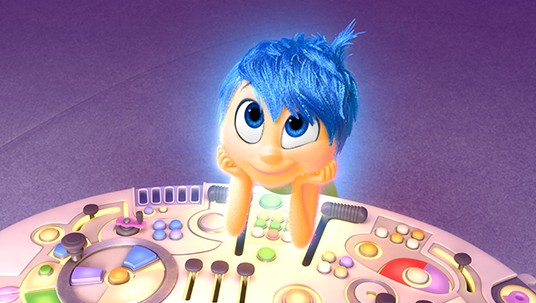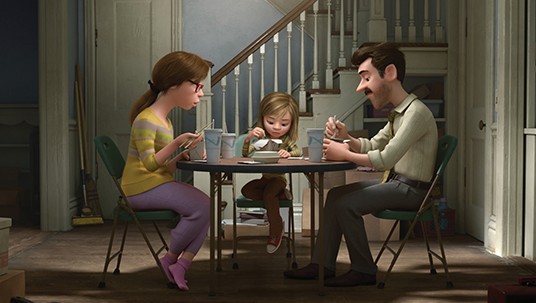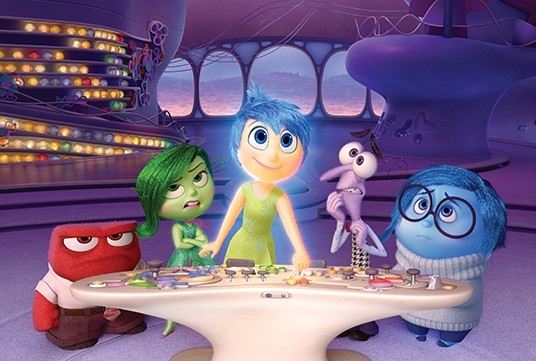Why Does Joy Have Blue Hair? It’s a question many have asked since the release of Pixar’s Inside Out. This article delves into the fascinating reasons behind this design choice, exploring the character’s complexity and the deeper meanings embedded in the film. For those seeking to understand the nuances of character design and the emotional landscape of Inside Out, WHY.EDU.VN offers a treasure trove of information and expert insights. Explore more about film analysis, character development, and the psychology behind storytelling at WHY.EDU.VN.
1. The Genesis of the Emotions: Shapes and Colors
The visual conception of the Emotions in Inside Out was a stroke of genius, spearheaded by character art director Albert Lozano. Each Emotion was not just assigned a color, but also a distinct shape that reflected their personality and role within Riley’s mind.
1.1 Joy: A Golden Starburst
Joy, the protagonist, was initially envisioned as a star – a symbol of brilliance, energy, and optimism. Her golden hue represented her radiant nature and her role as a source of happiness for Riley. The “illuminated, almost like a spark—like an explosion” description perfectly captures her dynamic and effervescent personality.
1.2 Sadness: A Teardrop of Emotion
In stark contrast, Sadness was designed as a teardrop, embodying her melancholic nature. The shape and color immediately convey her association with sorrow and grief. The imagery of her hair as “almost a waterfall” further emphasizes the constant flow of sadness and her tendency to be overwhelmed by her emotions.
1.3 Fear: A Tightly Wound Nerve
Fear’s design is equally evocative. Represented as a “raw nerve,” he is depicted as tense, anxious, and perpetually on edge. The “straight line” symbolizes his rigid and conservative nature, always alert to potential threats.
1.4 Anger: A Brutal Brick
Anger’s character is visualized as a brick – a solid, unyielding block of fury. This “brutal briquette that won’t stop” perfectly encapsulates his explosive temper and his tendency to react with force.
1.5 Disgust: A Stalk of Broccoli
Disgust, in a humorous yet insightful touch, was designed as a stalk of broccoli. This choice reflects the common childhood aversion to the vegetable, symbolizing her role in protecting Riley from physical and social toxins.
| Emotion | Shape | Color | Description |
|---|---|---|---|
| Joy | Star | Golden | Illuminated, like a spark |
| Sadness | Teardrop | Blue | Hair like a waterfall |
| Fear | Raw Nerve | Purple | Tight, conservative, wound up |
| Anger | Brick | Red | Brutal, unyielding |
| Disgust | Broccoli | Green | Aversive, protective |




2. Designing “Headquarters”: Where Emotions Reside
The concept of “Headquarters,” the control center of Riley’s mind, was meticulously crafted to be both functional and visually engaging. The filmmakers drew inspiration from diverse sources to create a space that felt both familiar and fantastical.
2.1 Inspiration from Star Wars and Apple Stores
Producer Jonas Rivera mentioned the Millennium Falcon from Star Wars as a key influence. The goal was to create a control panel with buttons and levers that viewers would intuitively understand, even without knowing their specific functions. This approach aimed to create a sense of immersion and believability. Rivera also noted that they wanted the whole room to feel almost like this combination of it’s a small world and an Apple Store. It was just clinical enough to work and be functional and so forth.
2.2 A Blend of Functionality and Whimsy
The art department worked to strike a balance between clinical functionality and playful whimsy. The design of Headquarters needed to be believable as a control center, yet also reflect the imaginative world of a child’s mind. The result was a space that felt both high-tech and inviting, with elements that hinted at the wonders of the human mind.
Image: A detailed look at the Headquarters control panel from Inside Out, showcasing its blend of functionality and whimsical design elements.
3. The Significance of Blue Hair: Why Joy Isn’t Just Yellow
One of the most intriguing design choices in Inside Out is Joy’s blue hair. Director Pete Docter explained that this decision was deliberate, serving a deeper purpose than mere aesthetics.
3.1 A Visual Complexity
Giving Joy blue hair, which was completely opposite of yellow, just rounded her out and made her a more visually complex character. While yellow represents happiness and optimism, the addition of blue introduces a hint of sadness and introspection. This complexity is crucial to Joy’s character arc, as she learns to understand and appreciate the importance of sadness.
3.2 Embracing the Full Spectrum of Emotions
The blue in Joy’s hair symbolizes the idea that even in moments of happiness, there can be a trace of sadness or melancholy. This reflects the reality that emotions are rarely pure and often exist in a complex interplay. By incorporating blue into Joy’s design, the filmmakers subtly acknowledged the importance of embracing the full spectrum of emotions, rather than solely focusing on happiness.
3.3 Acknowledging Sadness from the Beginning
Pete Docter said, “And we liked the idea that even though she doesn’t understand sadness, she has an element of that in her right from the very beginning.” This statement underscores the idea that Joy’s journey is about learning to accept and integrate sadness into her understanding of emotions. The blue hair serves as a visual reminder that sadness is an inherent part of the human experience, even for those who strive for happiness.
4. Amy Poehler as Joy: More Than Just a Voice
The casting of Amy Poehler as the voice of Joy was a masterstroke. Poehler’s comedic talent and her ability to convey both optimism and vulnerability made her the perfect choice for the role.
4.1 A Collaborative Writing Process
Instead of immediately recording her lines, Poehler spent a day reading through the entire script, offering her insights and suggestions. Pete Docter noted that, “She has such a brilliant writing mind as well as being an amazing performer. We took advantage of that.” This collaborative approach allowed Poehler to shape the character of Joy in a way that felt authentic and nuanced.
4.2 Narrating Other Characters’ Lines
Poehler’s involvement extended beyond just voicing Joy. She also narrated some of the lines for other characters, providing a unique perspective and helping to refine the overall tone of the film. This demonstrates her deep understanding of the story and her commitment to bringing the characters to life.
5. The Casting of Fear, Sadness, Anger, and Disgust: A Perfect Ensemble
The success of Inside Out is also due to the impeccable casting of the other Emotions. Each actor brought a unique sensibility to their role, creating a memorable and relatable ensemble.
5.1 Bill Hader as Fear: A Fan of Pixar
Bill Hader, known for his work on Saturday Night Live, was a perfect fit for the role of Fear. His comedic timing and his ability to convey anxiety made him an ideal choice. Interestingly, Hader was a huge fan of Pixar and even visited the studio on his own accord. Jonas Rivera said, “We just fell in love with him. He came on to write with us—he’s a great writer and he was so much fun in the story room.”
5.2 Phyllis Smith as Sadness: The Hesitant Voice
Phyllis Smith, known for her role in The Office, brought a quiet vulnerability to the character of Sadness. Jonas Rivera recounted seeing her in the movie Bad Teacher and being struck by her hesitant demeanor. “Everything had a question mark and that felt right. It worked. That’s how we ended up playing the character—she just nailed it.”
5.3 Lewis Black as Anger: A Natural Fit
Lewis Black, a renowned comedian known for his angry rants, was a natural choice for the role of Anger. His distinctive voice and his ability to convey rage made him the perfect embodiment of the character. Black’s casting was so fitting that Pixar even sent him a package explaining the studio and the role, fearing he might not be familiar with their work.
5.4 Mindy Kaling as Disgust: A Lover of Pixar
Mindy Kaling, known for her writing and acting in The Office and The Mindy Project, brought a sharp wit and a sophisticated sensibility to the role of Disgust. Her appreciation for Pixar’s storytelling made her a valuable addition to the cast. Mindy Kaling said, “It’s almost as if Pixar and Pete and Jonas and the experience of working with them is like dating a guy. It’s like this really well-raised guy that doesn’t know that he looks like Tom Brady.”
Image: The core Emotions from Inside Out – Joy, Sadness, Fear, Anger, and Disgust – each uniquely designed to reflect their individual personalities.
6. Riley’s Age: The Crossroads of Childhood
The decision to make Riley 11 years old was a deliberate choice, reflecting a pivotal moment in a child’s development.
6.1 The Fork in the Road
Jonas Rivera described this age as “the fork in the road for most kids.” It’s a time when children begin to experience more complex emotions and navigate the challenges of adolescence. The filmmakers wanted to capture this transition in a way that felt authentic and relatable.
6.2 Finding the Right Age
Pete Docter explained that they “did kind of hedge up and down around 11, just trying to find exactly the right age where you’re becoming an adult.” They consulted with parents and experts to pinpoint the age at which children begin to grapple with more adult emotions and experiences.
6.3 A Time of Possibility
Amy Poehler characterized this age as “that moment before you know you’ve been thrown in the snake pit, where you’re just like all possibility and really open-faced and just ready for everything.” She described it as a “magic hour” when children are still full of optimism and potential.
7. The Recording Process: A Collaborative Effort
The recording process for Inside Out was highly collaborative, with the actors working closely with the directors and each other to bring the characters to life.
7.1 Reading with Pete Docter
Bill Hader revealed that he and Mindy Kaling were “all actually reading with Pete.” This allowed them to respond to Docter’s direction and create a more natural and spontaneous performance.
7.2 Working with Amy Poehler
Phyllis Smith praised Amy Poehler for her support and guidance during the recording process. Poehler helped Smith with her lines, offering suggestions and tweaks to enhance her performance.
Image: Amy Poehler (Joy) and Phyllis Smith (Sadness) in a recording session, highlighting the collaborative spirit of the Inside Out cast.
8. The Pixar “Brain Trust”: A Source of Inspiration
The Pixar “brain trust,” a group of experienced filmmakers who provide feedback and support on each project, played a crucial role in the development of Inside Out.
8.1 Constructive Criticism
Pete Docter joked that “you could show Casablanca in that room and we would find things wrong with it and chip it apart.” This highlights the brain trust’s commitment to providing honest and critical feedback, even on beloved classics.
8.2 Targeted Notes
The brain trust’s feedback was always specific and targeted, focusing on the details that could be improved. This allowed the filmmakers to refine their vision and create a more compelling story.
9. Pixar’s Legacy: Inspiring Filmmakers and Audiences
Inside Out builds upon Pixar’s legacy of creating innovative and emotionally resonant films.
9.1 The Impact of Up
Mindy Kaling praised Up for its ability to “make me feel, as a writer, like ‘Wow, you can do anything.’” The film’s daring storytelling and its willingness to tackle complex emotions inspired Kaling and other filmmakers to push the boundaries of animation.
9.2 The Audacity of WALL•E
Amy Poehler admired WALL•E for its “audacity to make a movie like that… it’s kind of like the big risk, big reward philosophy of Pixar.” The film’s unconventional opening sequence, with minimal dialogue, demonstrated Pixar’s willingness to take risks and challenge audiences.
Image: The main cast of Inside Out at the premiere, celebrating the film’s innovative storytelling and emotional depth.
10. Why Inside Out is a Must-See Film
Inside Out is more than just an entertaining movie; it’s a film that offers valuable insights into the human experience.
10.1 Addressing the Challenges of Adolescence
Bill Hader noted that the film “chose to make a film about a time in your life that we all have to go through… A lot of normal movies don’t talk about that.” Inside Out confronts the challenges of adolescence head-on, providing a framework for understanding and navigating complex emotions.
10.2 Providing Answers and Validation
Hader expressed his wish that Inside Out had existed when he was a kid, because “you look for answers and you think you’re the only one going through this thing.” The film offers validation and reassurance to young viewers, letting them know that their emotions are normal and that they are not alone.
10.3 A Beautiful and Fantastic Approach
Inside Out tackles difficult topics in a way that is both beautiful and fantastic. The film’s imaginative world and its relatable characters make it accessible to audiences of all ages.
11. Understanding the Five Search Intentions
To fully appreciate the depth and relevance of Inside Out, it’s essential to understand the five key search intentions that drive people to seek information about the film and its characters.
11.1 Informational: Understanding Joy’s Blue Hair
Many viewers are curious about the specific design choices in Inside Out, such as why Joy has blue hair. This search intention reflects a desire to understand the symbolism and deeper meanings behind the film’s visual elements.
11.2 Navigational: Finding More About the Movie
Some users may be searching for specific information about the film, such as its release date, cast, or plot synopsis. This search intention reflects a desire to navigate to a specific resource or page related to Inside Out.
11.3 Commercial: Purchasing the Movie
Viewers who enjoyed Inside Out may be interested in purchasing the movie on DVD, Blu-ray, or digital download. This search intention reflects a desire to make a transaction and own a copy of the film.
11.4 Transactional: Streaming the Movie Online
Many users may be searching for ways to stream Inside Out online, either through subscription services or rental platforms. This search intention reflects a desire to access the film immediately and conveniently.
11.5 Investigational: Analyzing the Movie’s Themes
Some viewers may be interested in exploring the deeper themes and messages of Inside Out, such as the importance of emotions, the challenges of adolescence, and the power of memories. This search intention reflects a desire to engage with the film on a more intellectual level and understand its underlying meaning.
12. FAQ: Frequently Asked Questions About Inside Out and Joy’s Blue Hair
To further address the curiosity surrounding Inside Out and Joy’s unique design, here are some frequently asked questions:
| Question | Answer |
|---|---|
| Why does Joy have blue hair in Inside Out? | The blue hair represents a visual complexity, hinting at sadness and introspection even within happiness, symbolizing a balanced emotional spectrum. |
| What does Joy’s yellow color symbolize? | The yellow color symbolizes happiness, optimism, and energy, reflecting her primary role in bringing joy to Riley’s life. |
| What is the significance of Headquarters in Inside Out? | Headquarters is the control center of Riley’s mind, representing the complex interplay of emotions and thoughts that shape her personality and behavior. |
| Why was Riley chosen to be 11 years old? | Eleven years old is a pivotal age, marking the transition from childhood to adolescence, a time of significant emotional and social changes. |
| What inspired the design of the Emotions? | The Emotions were designed with distinct shapes and colors to reflect their personalities, such as Joy as a star and Sadness as a teardrop. |
| How did Amy Poehler contribute to the character of Joy? | Amy Poehler not only voiced Joy but also collaborated on the script, providing insights and suggestions that helped shape the character’s development. |
| What is the role of the Pixar “brain trust”? | The Pixar “brain trust” provides constructive criticism and feedback on each film, helping to refine the story and ensure its emotional resonance. |
| What makes Inside Out a unique and important film? | Inside Out addresses the challenges of adolescence and explores the importance of all emotions, offering validation and understanding to viewers of all ages. |
| How does Inside Out relate to other Pixar films? | Inside Out builds upon Pixar’s legacy of creating innovative and emotionally resonant films, pushing the boundaries of animation and storytelling. |
| Where can I learn more about Inside Out? | You can explore more about film analysis, character development, and the psychology behind storytelling at WHY.EDU.VN. |
13. Discover More at WHY.EDU.VN
Delving into the intricacies of Inside Out and understanding why Joy has blue hair is just the beginning. At WHY.EDU.VN, you can explore a vast universe of knowledge, from film analysis to scientific explanations, all presented in an accessible and engaging manner.
13.1 Your Questions, Our Expertise
Do you have burning questions that need answers? Are you seeking deeper insights into the world around you? WHY.EDU.VN is your go-to resource for reliable information and expert perspectives. Our team of dedicated professionals is committed to providing you with accurate and comprehensive answers to all your queries.
13.2 Connect With Us
Ready to unlock a world of knowledge? Visit us at WHY.EDU.VN and start exploring today. Have a specific question in mind? Don’t hesitate to reach out to us using the contact information below:
- Address: 101 Curiosity Lane, Answer Town, CA 90210, United States
- WhatsApp: +1 (213) 555-0101
- Website: WHY.EDU.VN
Let WHY.EDU.VN be your guide on a journey of discovery and enlightenment. Whether you’re a student, a professional, or simply a curious mind, we have something to offer everyone. Visit why.edu.vn today and start exploring the world of knowledge!